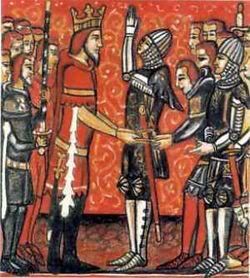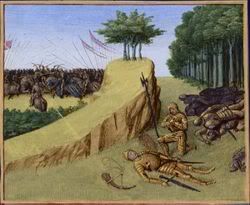From Wikipedia, the free encyclopedia - Online Research & Study
Jump to: navigation, search
For other uses, see Paladin (disambiguation).
"Paladine" redirects here. For the Dragonlance fictional deity, see Paladine (Dragonlance).
A paladin (alternatively paladine, also spelled palatine, or Latin palatinus, -i) is any of diverse officials found in numerous countries of medieval and early modern Europe.
It has existed in history first in Ancient Rome as an official of the Emperor as well as a corps of the praetorian guard (Diocletian), named after its neighboring Scholae Palatinae. In the early Middle Ages there was a papal church official or a noble close to the king (see below), in the late Middle Ages a synonym of count palatine, in Modernity it was in 19th century Hungary the supreme title given by the king or, in a broader sense especially around 1900 in Britain and the German Empire, a knight.
In fiction the paladines were twelve heroes of mediaeval poetry. In this context the term retains the meaning of “honourable knight”.
Contents[hide]
1 Derivative terms
1.1 Ancient Rome
1.2 Middle Ages: Holy Roman Empire
1.3 Middle Ages: Catholic Church
1.4 Early Modern Usage
1.5 19th and 20th century
2 Fiction
2.1 Carolingian Court
2.2 Renaissance
2.3 19th century Revival
3 Present Day and Trivia
4 Sources
//
[edit] Derivative terms
The different spellings originate from the different languages that used the title throughout the ages (a phenomenon called lenition). The word "paladin" evolved from the Latin word palatinus, meaning "belonging to the Palatine Hill", where the house of the Roman emperor was situated since Octavian. The meaning of the term changed only little, but was changed to the pronunciation of the European languages: Latin palatinus, plural palatini, English paladin and paladine, French palaisin and German Paladin. The term was also adopted to describe the residence of the Ancient Roman palatinus, the palatium. In the early Middle Ages the German “paladin” was the elector of the King, given the palatinate to have a territory as a basis to sustain him (Pfalz).
The word palace also developed from “palatium”, so that a paladin was in one sense a palace official. Other uses are the titles of "mayor of the palace" and "count palatine". The original Middle French form is palaisin. The English paladin was loaned into Early Modern English from the Italian form, paladino, because late medieval treatments of the "Matter of France" were mostly by Italian authors such as Ludovico Ariosto and Matteo Maria Boiardo.
[edit] Ancient Rome
The Scholae Palatinae, named after its location on Palatine Hill, the mythical founding place of Rome, was the older of two schools of the ancient Salii brotherhood of God of War Mars, which lent some of their symbols to the emperial, later the papal palace.
Official and ceremonial hat of the Salii used later adopted by the Catholic Church
Originally the term was applied to the chamberlains and to some troops guarding the palace of the Roman emperor. In Constantine's time, the title was also used for the most advanced field force of the army, the Praetorian Guard, that might guard the Roman Emperor on campaigns. The traditions of the two groups of 12 Salii priests and of the Praetorian Guard soon merged into one, creating an image of an influential official with nonphysical connotations.
[edit] Middle Ages: Holy Roman Empire
From the Middle Ages on, the term palatine was applied to various different officials across Europe. The most important of these was the count palatine, who in Merovingian and Carolingian times (5th through 10th century) was an official of the sovereign's household, in particular of his court of law. The count palatine was the official representative at proceedings of the court such as oath takings or judicial sentences and was in charge of the records of those developments. At first he examined cases in the king's court and was authorized to carry out the decisions, in time, these rights extended to having own judicial rights. In addition to those responsibilities, the count palatine had administrative functions, especially concerning the king's household.
After Carolingean times France was split from the Holy Roman Empire, and under the German kings of the Saxon and Salian dynasties (10th to 12th century), the function of the counts palatine corresponded to those of the missi dominici at the Carolingian Court. They had various tasks: representatives of the king in the provinces, they were responsible for the administration of the royal domain and for the protecting and guiding the legal system in certain duchies, such as Saxony and Bavaria, and, in particular, Lotharingia. Later other palatine rights were absorbed by ducal dynasties, by local families, or, in Italy, by bishops. Increasigly, the count palatine of Lotharingia, whose office had been attached to the royal palace at Aachen from the 10th century onward, became the real successor to the Carolingian count palatine. From his office grew the Countship Palatine of the Rhine, or simply the Palatinate, which became a great territorial power from the time of the emperor Frederick I (Barbarossa) (d. 1190) on. The term palatine reoccurs under Charles IV, but they had only voluntary jurisdiction and some honorific functions.
The word palatinus and its derivatives also translate the titles of certain great functionaries in eastern Europe, such as the Polish wojewoda, a military governor of a province.
[edit] Middle Ages: Catholic Church
For the main article, see Palatinus (Roman Catholic Church)
In the Middle Ages, the judices palatini ('[papal] palace judges') were the highest administrative officers of the pope's household; with the growth of the temporal power of the popes they acquired great importance.
[edit] Early Modern Usage
In England the term palatinate, or county palatine, was applied to counties of lords who could exercise powers normally reserved to the crown. Likewise, there were palatine provinces among the English colonies in North America: Cecilius Calvert, Lord Baltimore, was granted palatine rights in Maryland in 1632, as were the proprietors of the Carolinas in 1663.[1]
[edit] 19th and 20th century
In Germany and Britain, paladin was an official rank and considered an honorary title for one in service of the emperors. It was a Knight with additional honours.
During the second reinstating of a German Empire called the Third Reich, Hermann Göring was also given the title “Paladin”, referring to the tradition of a title that made the carrier second to the king.[2]
[edit] Fiction
[edit] Carolingian Court

Roland is girt with a sword by Charlemagne; from a manuscript of a chanson de geste.
Paladin as a word referring to a champion or warrior of the European Middle Ages is often used to describe Charlemagne's legendary retainers, the Twelve Peers of mediaeval chansons de geste and romances. In the original Latin version, naturally palatinus was used. These characters and their associated exploits are largely later fictional inventions, with some basis on historical Frankish retainers of the 8th century and events such as the Battle of Roncevaux Pass and the confrontation of the Frankish Empire with Umayyad Al-Andalus in the Marca Hispanica
The names of the twelve paladins vary from romance to romance, and often more than twelve paladins are named. The number is popular because it resembles the twelve Apostles – giving the king the position of Jesus not out of arrogance, but the conscience of the holy mission a king has. All Carolingian paladine stories feature paladins by the names of Roland and Oliver. Other recurring characters are Archbishop Turpin, Ogier the Dane, Huon of Bordeaux, Fierabras, Renaud de Montauban, and Ganelon. Tales of the paladins of Charlemagne once rivalled the stories of King Arthur and the knights of the Round Table in popularity. Ariosto and Boiardo, whose works were once as widely read and respected as Shakespeare's, contributed most prominently to the literary/poetical reworking of the tales of the epic deeds of the paladins.

The death of Roland at the Battle of Roncevaux, from an illustrated manuscript of the 1450s.
The twelve paladins of Charlemagne are listed in the Old French Chanson de Roland as follows:
Roland — Charlemagne's nephew and the chief hero among the paladins
Oliver — Roland's friend and strongest ally
and Gérin, Gérier, Bérengier, Otton, Samson, Engelier, Ivon, Ivoire, Anséis, Girard (similar spellings are possible).
[edit] Renaissance
The Italians Ariosto and Boiardo listed the paladins quite differently, but kept the number of twelve:
Orlando — Roland, Charlemagne's nephew and the chief hero among the paladins)
Oliver — rival to Roland
Ferumbras — (Fierabras), the Saracen who became a Christian
Astolpho — descended from Charles Martel and cousin to Orlando
Ogier the Dane
Ganelon the betrayer, who appears in Canto XXXII of the Inferno by Dante Alighieri
Rinaldo — Renaud de Montauban
Malagigi — Maugris, a sorcerer
Florismart — friend to Orlando
Guy de Bourgogne
Namo — (Naimon, Aymon, or Namus), Rinaldo's father
Otuel — another converted Saracen
[edit] 19th century Revival
The Celtic revival of the 1880s benefitted the Arthurian material and encouraged its reworking and recirculation. No such aura of latter-day romance could assist the Charlemagne material, which remained strongly Christian and triumphalist in its presentation in contrast to the melancholy of the ultimate failure of the Arthurian heroes, and their ambiguous position at the transition from Celtic paganism to Christianity. As a result, contemporary readers know Arthur and his Camelot well while hearing little of the paladins of Charlemagne, who once enjoyed similar renown.
[edit] Present Day and Trivia
The official title has come out of fashion, but the meaning of a character full of virtue remains, and one called a paladin is meant to be a thoughtful, virtuous man. Given the history of the term, it would give a wrong impression, since a paladin is in a way close to a monk.
Some modern role playing games and fantasy literature make use of a "paladin" character class based on the medieval concept. For computers, board games and many more there are popular game characters listed on paladin (disambiguation). Fantasy paladins are usually holy warriors, combining both combat and healing abilities.
Also, as 19th and early 20th century politics, paladin/paladine might be a honorary title in reality or fiction.
[edit] Sources
Conradus the priest (12th century), Song of Roland. ISBN 3-920153-02-2. Frank, Grace, La Passion du Palatinus : mystère du XIVe siècle, in : Les Classiques français du moyen âge (30) Paris 1922.
^ John Krugler, English and Catholic, the Lords Baltimore in the seventeenth century, Baltimore 2004.
^ Stefan Marthens, Erster Paladin des Führers und Zweiter Mann im Reich, Paderborn 1985, ISBN 3-506-77474-3, and Wolfgang Paul, Hermann Goering: Hitler Paladin or Puppet?, London 1998, ISBN 1-85409-429-7
Retrieved from "http://en.wikipedia.org/wiki/Paladin"
Categories: Cleanup from December 2006 All pages needing cleanup Knights Matter of France Stock characters History of Rome Lists of office-holders Titles Noble titles Ancient Roman titles Military ranks of ancient Rome













No comments:
Post a Comment